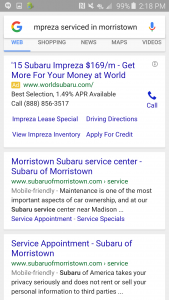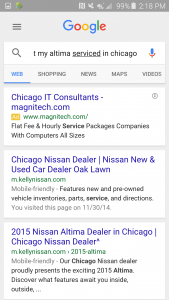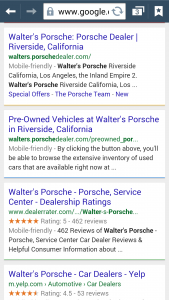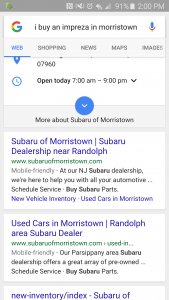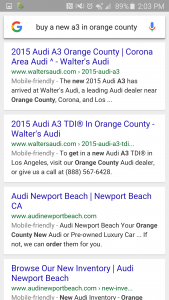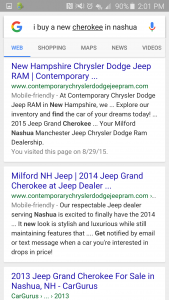Everyone knows that on-site content is important for rankings, engagement, and so on. So let’s just cut to the chase and talk about why it’s necessary, how it can be accomplished, and what the results can look like if and when it’s done right.
Let’s start by explaining how search algorithms work. I won’t bore you with the technical explanation, I’m going to just call it like it is. People ask questions. That’s it, people ask questions and they want those questions answered in the quickest and most relevant way possible. How does this relate to a search algorithm? The answer is simple; search engines want to show the most relevant content to their users. So, are you developing a strategy to answer the common questions that your customers could ask? Lets look at a few scenarios.
Scenario 1: My Car Broke Down
Since people ask questions, the internet (or search) should be able to understand these questions and give the user the answer they seek with the most relevant content possible. Hypothetically, you have a car, and this car breaks. Now imagine you were in one of those situations where you got up late, forgot breakfast, didn’t shower, Glenn Pasch is getting on your back about showing up to work late (again), and you run out of the house forgetting your precious smartphone. I know, it’s a scary thought.
So there you are, in a broken down car on the side of the road, thinking to yourself, “Is Glenn going to yell at me today?” “Is my cell phone ok?” And lastly, “I wish I knew where I could get (this piece of $#%@) my car serviced in [location].” That’s it, that’s how you ask the question and that’s how a search engine should understand your intent.
But guess what? Who forgets their smartphone at home? No one. Ever. It’s 2015 and that cell phone is like a third hand, so you instantly use it to go to Google for help.
Look what happens when you ask a search engine a question. The content that shows up is highly relevant to the users intent and also to the website’s (company’s) goal: to get the user to their site as simply as possible.
How was this accomplished? PCG developed a content strategy around each one of these client’s goals. Development and optimization of current content, both user-facing and back-end, based on the these goals allowed PCG to create a three to six month strategy focusing on increasing visibility and generating traffic to/from a mix of keywords, including [geo][brand]service, [geo][model]service, [brand]service, [model]service, etc.
What did the results look like? Each client saw varied results but all saw improvements. Although exact numbers cannot be shared, the minimum increase in traffic to service related page visits was 27%, with the maximum increase being 137% when comparing year over year stats. Visible keywords increased at a minimum of 81% and a maximum of 312%, again, while comparing year over year stats. Month to month traffic growth ranged from 10% to 30%. The highest increases happened between months four and six, showing the importance of a monthly, consistent SEO and content marketing plan.
Scenario 2: I Want a New Car
Maybe that hoopty just isn’t worth the price to repair and it’s time to invest in a fancy new ride. What are you looking for? A Wagon? SUV? Sedan?
Just like the service examples above, Google is showing me relevant information based on my search query. I’m looking for an A3 or a Cherokee, therefore I get content focused on the A3 and Cherokee, etc. Let’s move on.
If You’re Still Questioning Investing in Content, Here’s Why You Shouldn’t.
I was recently looking to upgrade my Wrangler to a newer model. Upon visiting the same dealership, I didn’t have a single person come up to me and talk to me about my intentions. My third, and last, visit to that dealership, I decided to look at multiple $50k-$60k Grand Cherokee SRT8’s and Rubicons. Again, not a single sales person walked up to me. I was ready to buy, but that dealership is employing a group of salespeople that are virtually useless.
The content created on your site targets people looking to either purchase a vehicle, get service, or research a new buy. Don’t question that mild investment in content when in reality, you’re already making poor investments in the team you are entrusting to sell cars.
Start Competing
Are you still running billboards? TV commercials? Radio commercials? How much does that cost compared to an investment in content that’s generally under $1000 per month? Let’s ask the hard-hitting question: how many people are coming to your site from these forms of advertising? Don’t lie to me, you have no clue. Content not only targets users in search, but you can also track how many people are coming to your site, engaging with that content, and how those users are interacting with your entire site. Don’t question a small investment in content if you’re still throwing money away on antiquated forms of marketing that offer very limited forms (if any) of tracking or targeting.
The “Millennial Consumer” is all digital, all the time. They’re on Facebook, YouTube, reading blogs, you name it. The people with buying power aren’t interested in your “Year End Clearance” sale, they’re interested in relevant information, trustworthy brands, and working with a business they can build a relationship with. So, give them what they want by developing a content strategy that markets your products through knowledge and education, not through “beating any price” and “no hassle shopping.”
Can’t figure out the first step? Give PCG a call, we can walk through it together.
